This article was medically reviewed by Julia Bowlin, MD. Dr. Bowlin is a practicing Family Practitioner in Greenville, Ohio specializing in Allergy and Immunology. She received her MD from the Wright State University Boonshoft School of Medicine and completed her residency at the Franciscan Medical Center in Dayton, Ohio. She has over 25 years of practicing experience.
There are 13 references cited in this article, which can be found at the bottom of the page.
wikiHow marks an article as reader-approved once it receives enough positive feedback. This article received 62 testimonials and 93% of readers who voted found it helpful, earning it our reader-approved status.
This article has been viewed 3,698,536 times.
Nose bleeds, also known as epistaxis, are a common complaint which can occur spontaneously. Nose bleeds occur when the inner lining of one’s nose is hurt or dry. The resulting damage to small blood vessels in the nose induces bleeding. Almost all nose bleeds originate from blood vessels in the front part of the nasal septum, which is the inside middle tissue separating both nostrils. Nose bleeds occur more frequently in patients with nasal allergies, sinusitis, hypertension, or bleeding disorders. [1] If you understand the causes of nose bleeds and know how to handle them, you can better manage your own nose bleeds and prevent future bleeding.
Steps
Performing First-Aid During a Nose Bleed
-
1Position your body. If you do not have a serious issue that led to your nose bleed, you can perform some first aid at home during a nose bleed to help stop it. To begin, sit down, since it is more comfortable than standing. Tilt head forward so that the blood drains through the nostrils.
- A towel can be held under your nose to collect the blood.
- Do not lie down as this can cause blood to pass down the throat.
-
2Compress the nose. With a finger and thumb, pinch the lower fleshy end of the nose, completely blocking the nostrils. Pinching at this point directly applies pressure at the region where the blood vessels are damaged. This makes the move more effective since it will help stop the flow of blood. Keep pinching the nose for 10 minutes, then release.
- If bleeding continues, reapply pressure for another 10 minutes.
- While you do this, breathe through the mouth.
Advertisement -
3Cool yourself down. Lowering your body temperature can help reduce the blood flow to your nose. To do this, place ice cubes in your mouth. This helps achieve a lower temperature sooner than cooling the external part of the nose. It also will help you retain the lower temperature for longer.
- This is more effective than placing a cold compress over the nose. Cold compresses placed over the nose are not very effective according to a recent clinical study.
- You can also suck on a popsicle to achieve the same result.[2]
-
4Use oxymetazoline nasal sprays. While you have a nose bleed but not on a regular basis, you can try a medicated nose spray if you do not have high blood pressure issues. This medication causes constriction of the blood vessels in your nose. To use, take a small clean cotton ball or gauze piece, add 1-2 drops of the spray to it, insert them into the nostrils, continue pinching the nostrils, and check for bleeding after 10 minutes.[3]
- If bleeding has stopped, do not remove the cotton or gauze for about an hour, because bleeding can reoccur.
- Frequent use of this drug, which is more than 3-4 days at a time, can cause addiction and nasal congestion.
- These sprays are used only if bleeding does not stop on pinching the nose after the first 10 minutes.
-
5Wash your nose and rest. After bleeding has stopped, you can clean the area around your nose with warm water. After you have cleaned your face, you should rest for a while. This is to help to prevent further bleeding.
- You can lie down while resting.
Preventing Future Nose Bleeds
-
1Be gentle on your nose. Since nose bleeds can be caused by personal actions, there are some preventative methods that will help you prevent nose bleeds in the future. You should avoid picking your nose. Picking can cause an injury to the inner sensitive blood vessels of the nose. It can also detach the blood clots covering previously injured blood vessels and cause further bleeding. You should also keep your mouth open while sneezing to prevent the expulsion of air through the nose.
- You should keep the inner lining of your nose moist by gently applying a coating of petroleum jelly or nasal gel inside your nose with a cotton swab twice a day.[4]
- Always blow your nose gently and do it one side at a time.
- You should also clip the fingernails of children to avoid further injury.
-
2Buy a humidifier. To increase the humidity in your environment, you should buy a humidifier. You can use a humidifier at home or work to prevent excessive dryness, especially in the wintertime.
- If you do not have a humidifier, a metal container with water can be placed on top of heating radiators to humidify the air.
-
3Increase your fiber intake. Constipation can lead to bearing down to pass hard stool, which causes an increase in nose bleeds because it strains your blood vessels. This can increase arterial pressure momentarily and dislodge blood clots covering previously injured blood vessels, which can eventually result in further nose bleeds. Constipation can be prevented by eating foods high in fiber and increasing your fluid intake.
-
4Eat fiber to keep stools soft. Do not bear down during bowel movements, since this increases the intra-cerebral arterial pressure thereby increasing the chance of small sensitive blood vessel rupture in the nose[5]
- Eating 6 to 12 prunes a day are more effective than dietary fibers and can be used to prevent constipation.[6]
- You should also avoid hot and spicy foods. Heat can dilate blood vessels and precipitate bleeding.
-
5Use saline nasal sprays. Saline nose sprays can be used several times each day to keep the nose moist.[7] These nasal sprays are not as addictive as they only contain salt. If you don't want to buy them, you can make your own.
- To make your own, take a clean container. Mix 3 heaping teaspoons of iodide-free salt and 1 rounded teaspoon of baking soda. Mix both the powders together. Then take 1 teaspoon of the powdered mixture and add it to 8 ounces of lukewarm distilled or boiled water. Mix well.[8]
-
6Eat more flavonoids. Flavonoids, which are a group of natural chemical compounds present in citrus fruits, can improve fragility of blood capillaries.[9] Because of this, you should consider increasing your consumption of citrus fruits. Other foods with a high flavonoid content include parsley, onions, blueberries and other berries, black tea, green tea and oolong tea, bananas, all citrus fruits, Ginkgo biloba, red wine, sea-buckthorns, and dark chocolate (with a cocoa content of 70% or greater).
- You should not take flavonoid supplements, such as ginkgo pills, quercetin tablets, grape seed extract, and flaxseed, because they result in a higher flavonoid content and eventual toxicity.[10]
Understanding Nose Bleeds
-
1Learn the types of nose bleeds. The types of nose bleeds rely on which part of the nose the bleeding comes from. In anterior nose bleeds, bleeding arises in the front part of the nose. You can also have a posterior nose bleeds, where bleeding originates in the inner part of the nose. Nose bleeds can also be spontaneous with an unidentifiable cause.[11]
-
2Know the causes. There are many causes for nose bleeds. When you get one, you should assess which of the causes is most likely the reason you got your nose bleed and avoid the situation if at all possible in the future. You can get a nose bleed because of self-induced trauma, mostly as a result of nasal picking. This is the most common cause in young children. Other causes include substance abuse of drugs such as cocaine, blood vessel disorders, blood clotting disorders, and trauma to the head or face.
- Environmental factors such as low humidity, which is common during the winter, can induce mucosal irritation and bleeding. The incidence of nasal bleeding increases in colder weather.
- Infections of the nose and sinuses can cause a nose bleed. Allergies can also cause mucosal inflammation, which leads to nose bleeds.
- In some special cases, migraine headaches in children have also been proposed as a causative.[12]
- Trauma to the face can also cause a nose bleed to occur.
-
3Avoid certain situations. If you get a nose bleed, you should avoid certain situations and actions which may make it worse. Do not lean backwards. This may cause blood to run down your throat, which could induce vomiting. You should also avoid speaking and coughing. This can irritate the nasal mucosa and re-bleeding can occur.
- If you have to sneeze while your nose is bleeding, you should try to expel the air through your mouth so you don't further hurt your nose or cause more bleeding.
- Do not blow or pick the nose, especially if the bleeding is decreasing. You can dislodge formed blood clots and bleeding can reoccur.
-
4Visit the doctor. There are certain situations when you need to visit a doctor. If the bleeding is severe, more than a few drops, lasts more than 30 minutes, and reoccurs frequently, you should see a doctor.[13] You also need to seek medical attention if you become extremely pale, fatigued, or disoriented. This can occur as a result of significant blood loss.
- If you have difficulty breathing, especially if blood passes down your throat, you need to see a doctor. This can lead to irritation and coughing. There is a chance of infection as a result, which can eventually cause breathing issues.
- You should always see a doctor if the nose bleed began as a result of severe injury to the nose.
- You should also see a doctor if you have a nose bleed while you are taking medicine that prevents blood clotting, such as warfarin, clopidogrel, or a daily aspirin.[14]
Expert Q&A
Did you know you can get expert answers for this article?
Unlock expert answers by supporting wikiHow
-
QuestionWhat if the pinching doesn't stop the bleeding no matter how long I do it?
 Angela Kerchner, MDDr. Kerchner is a board certified Family Medicine Physician in Des Moines, Iowa. She is the current Medical Director of Ringgold County Hospital. She received her MD from the University of Iowa Carver College of Medicine in 2010. She is also a Diplomate on the American Board of Integrative Holistic Medicine.
Angela Kerchner, MDDr. Kerchner is a board certified Family Medicine Physician in Des Moines, Iowa. She is the current Medical Director of Ringgold County Hospital. She received her MD from the University of Iowa Carver College of Medicine in 2010. She is also a Diplomate on the American Board of Integrative Holistic Medicine.
Board Certified Family Medicine Physician First, make sure that you are putting firm pressure on both sides of your nostrils and that you hold your nose that way for at least 20 minutes without letting go. If this does not slow down the bleeding, then it is possible that the bleeding is coming from further back in the nose and pinching will not reach the vessel. Also, consider any medicine you have taken recently. For example, aspirin or other medicines that decrease your body's ability to form blood clots may also make bleeding last longer. Try using ice and medicated nasal sprays. These can help to shrink the blood vessels and slow the bleeding. See your doctor if heavy bleeding continues.
First, make sure that you are putting firm pressure on both sides of your nostrils and that you hold your nose that way for at least 20 minutes without letting go. If this does not slow down the bleeding, then it is possible that the bleeding is coming from further back in the nose and pinching will not reach the vessel. Also, consider any medicine you have taken recently. For example, aspirin or other medicines that decrease your body's ability to form blood clots may also make bleeding last longer. Try using ice and medicated nasal sprays. These can help to shrink the blood vessels and slow the bleeding. See your doctor if heavy bleeding continues. -
QuestionWhat if you faint while having a nosebleed?
 Angela Kerchner, MDDr. Kerchner is a board certified Family Medicine Physician in Des Moines, Iowa. She is the current Medical Director of Ringgold County Hospital. She received her MD from the University of Iowa Carver College of Medicine in 2010. She is also a Diplomate on the American Board of Integrative Holistic Medicine.
Angela Kerchner, MDDr. Kerchner is a board certified Family Medicine Physician in Des Moines, Iowa. She is the current Medical Director of Ringgold County Hospital. She received her MD from the University of Iowa Carver College of Medicine in 2010. She is also a Diplomate on the American Board of Integrative Holistic Medicine.
Board Certified Family Medicine Physician Fainting during a nose bleed is common, especially if you are not used to seeing blood. However, fainting from a nose bleed is not usually dangerous. If you feel like you might faint, lie down in a safe place and if possible, raise your legs up on pillows. If you faint before you can do this, lie down after you regain consciousness and put your legs up on pillows. You can also lie on your side to prevent blood from running down your throat. If you fall and hit your head or have any serious injuries, see a doctor.
Fainting during a nose bleed is common, especially if you are not used to seeing blood. However, fainting from a nose bleed is not usually dangerous. If you feel like you might faint, lie down in a safe place and if possible, raise your legs up on pillows. If you faint before you can do this, lie down after you regain consciousness and put your legs up on pillows. You can also lie on your side to prevent blood from running down your throat. If you fall and hit your head or have any serious injuries, see a doctor. -
QuestionHow does a doctor cauterize your nose?
 Angela Kerchner, MDDr. Kerchner is a board certified Family Medicine Physician in Des Moines, Iowa. She is the current Medical Director of Ringgold County Hospital. She received her MD from the University of Iowa Carver College of Medicine in 2010. She is also a Diplomate on the American Board of Integrative Holistic Medicine.
Angela Kerchner, MDDr. Kerchner is a board certified Family Medicine Physician in Des Moines, Iowa. She is the current Medical Director of Ringgold County Hospital. She received her MD from the University of Iowa Carver College of Medicine in 2010. She is also a Diplomate on the American Board of Integrative Holistic Medicine.
Board Certified Family Medicine Physician If you have a vessel that continues to cause nosebleeds, your doctor may decide to cauterize the blood vessel that is causing the nosebleeds. To cauterize the vessel, your doctor will use a compound called silver nitrate to create a tiny burn on the vessel. This usually stops the nosebleeds. If the area that needs to be cauterized is large or in a very sensitive part of the nose, then your doctor will numb the area before cauterizing to decrease your discomfort.
If you have a vessel that continues to cause nosebleeds, your doctor may decide to cauterize the blood vessel that is causing the nosebleeds. To cauterize the vessel, your doctor will use a compound called silver nitrate to create a tiny burn on the vessel. This usually stops the nosebleeds. If the area that needs to be cauterized is large or in a very sensitive part of the nose, then your doctor will numb the area before cauterizing to decrease your discomfort.
References
- ↑ Purkey MR, Seeskin Z, Chandra R. Seasonal variation and predictors of epistaxis. Laryngoscope. 2014; 24(9):2028-2033.
- ↑ Porter M, Marais J, Tolley N. The effect of ice packs upon nasal mucosal blood flow. Acta Otolaryngol1991;111:1122-1125.
- ↑ http://sinus.wustl.edu/Details.aspx?ID=300
- ↑ Porter M, Marais J, Tolley N. The effect of ice packs upon nasal mucosal blood flow. Acta Otolaryngol1991;111:1122-1125.
- ↑ Ternent CA, Bastawrous AL, Morin NA, Ellis CN, Hyman NH, Buie WD, Standards Practice Task Force of The American Society of Colon and Rectal Surgeons. Practice parameters for the evaluation and management of constipation. Dis Colon Rectum. 2007;50(12):2013-2022.
- ↑ Attaluri A, Donahoe R, Valestin J, Brown K, Rao SS. Randomised clinical trial: dried plums (prunes) vs. psyllium for constipation. Aliment Pharmacol Ther. 2011;33(7):822-828.
- ↑ http://emedicine.medscape.com/article/863220-treatment
- ↑ http://aaaai.org/conditions-and-treatments/library/allergy-library/saline-sinus-rinse-recipe.aspx
- ↑ Galley P, Thiollet M. A double-blind, placebo-controlled trial of a new veno-active flavonoid fraction (S 5682) in the treatment of symptomatic capillary fragility. Int Angiol. 1993;12(1):69-72.
- ↑ http://www.berkeley.edu/news/media/releases/2000/09/19_flav.html
- ↑ Rudmik L, Smith TL. Management of intractable spontaneous epistaxis. Am J Rhinol Allergy. 2012;26(1):55–60.
- ↑ Jarjour IT, Jarjour LK. Migraine and recurrent epistaxis in children. Pediatr Neurol. 2005;33(2):94-97.
- ↑ http://sinus.wustl.edu/Details.aspx?ID=300
- ↑ http://www.uptodate.com/contents/nosebleeds-epistaxis-beyond-the-basics
About This Article
To stop a nose bleed, start by tilting your head forward so the blood drains out your nostril and not down your throat. Then, pinch the lower fleshy end of your nose between your index finger and thumb and hold it like that for 10 minutes. If your nose is still bleeding after that, keep pinching it for an additional 10 minutes. You can also try sucking on an ice cube, which will lower your body temperature and reduce the blood flow to your nose. To learn how to prevent nose bleeds in the future, scroll down!

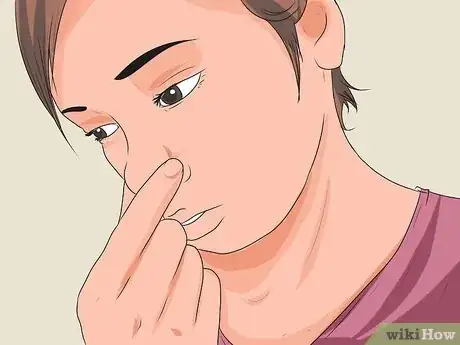
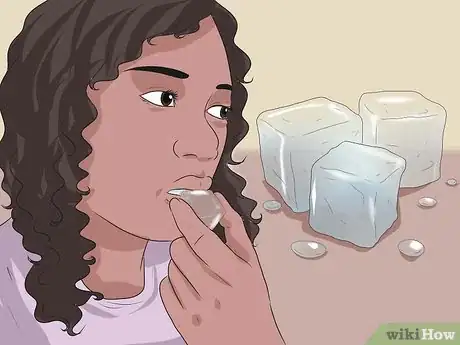
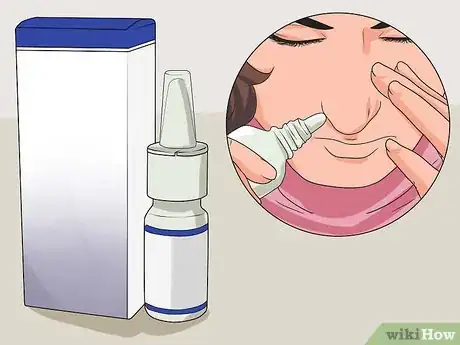
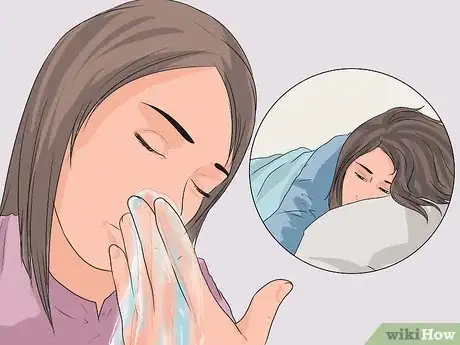

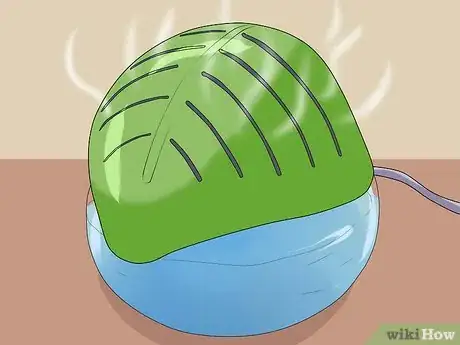

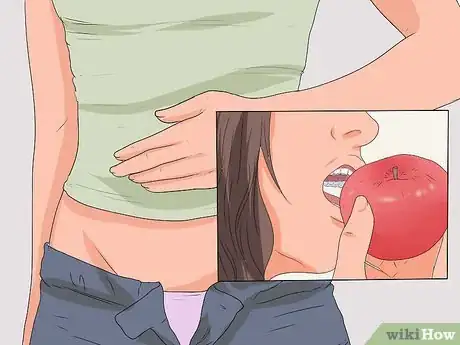
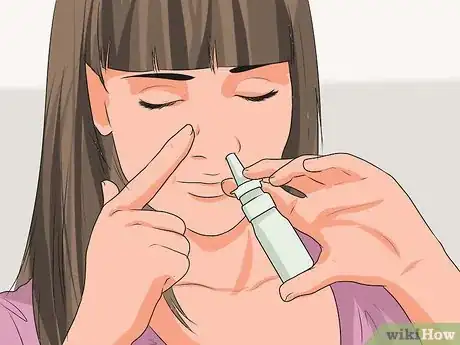

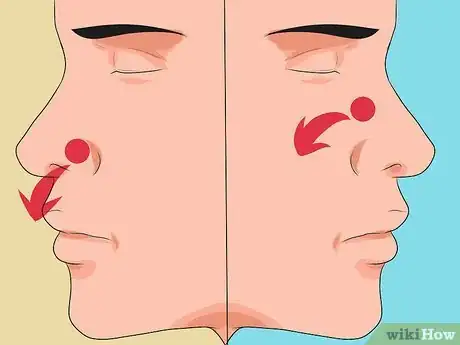
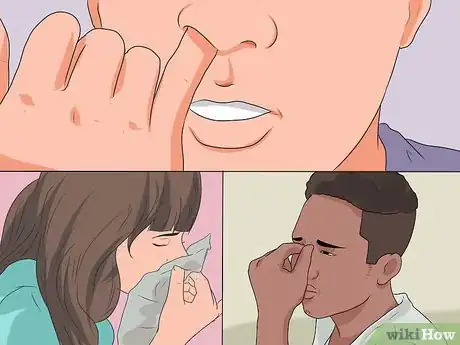
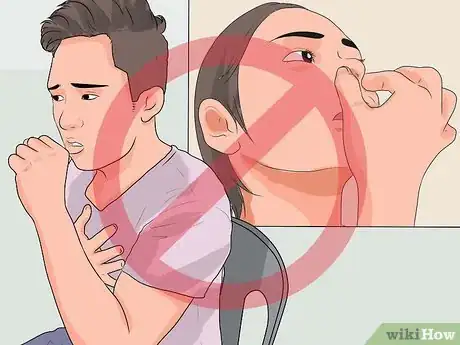




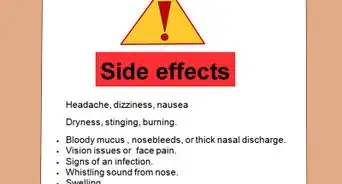




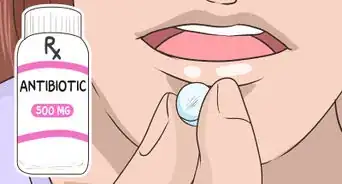
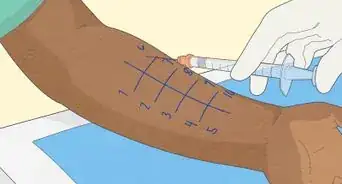

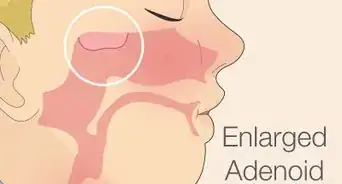









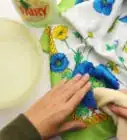


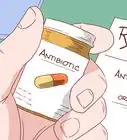



































Medical Disclaimer
The content of this article is not intended to be a substitute for professional medical advice, examination, diagnosis, or treatment. You should always contact your doctor or other qualified healthcare professional before starting, changing, or stopping any kind of health treatment.
Read More...